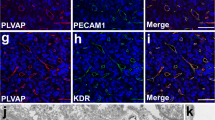Summary
Most capillary endothelial cells of the anterior pituitary of rats and rabbits are not vitally stained by acid dyes and india ink, while the pericapillary cells are intensively stained by acid dyes, especially by trypan blue. In electron micrographs, capillary endothelial cells have few lysosomes in their relatively scanty cytoplasm. These cells do not react markedly to repeated injections of acid dye whereas most pericapillary cells are increased in number and size after repeated injections of acid dye and show numerous lysosomal structures in the cytoplasm. These cells are considered to correspond to the acid dye-accumulating pericapillary cell observed by light microscopy.
From these facts, the present authors emphasize that the capillary endothelial cell of the anterior pituitary should be excluded from the reticulo-endothelial system, as it is a pericapillary histiocyte that is stained vitally by acid dyes.
The capillary endothelium has numerous fenestrae of 500 Å diameter, closed by a thin diaphragm. The diaphragm is not trilaminar but mono-layered and there is a dense ring-like structure in its central area. The overall diameter of the ring-like structure is about 200 Å and the light center is about 70 Å in diameter. It is suggested that the highly organized structures of the diaphragm may relate to the passage of substances such as acid dye from the capillary lumen into the pericapillary space.
Zusammenfassung
Die meisten Capillarendothelien der Hypophysenvorderlappen bei Ratten und Kaninchen zeigten auch bei wiederholter Injektion keine Vitalfärbung mit Lithiumcarmin oder Tusche, dagegen ließen sich die meisten pericapillären Zellen mit den sauren Farbstoffen, besonders mit Trypanblau, stark anfärben. Bei elektronenmikroskopischer Untersuchung findet man wenige Lysosomen im Cytoplasma der Capillarendothelien; auch ist an ihnen eine Reaktion auf die Vitalfärbung nicht deutlich zu beobachten. Die pericapillären Zellen erscheinen nach den wiederholten Injektionen des Vitalfarbstoffes vermehrt und enthalten viele kleine oder große Lysosomen im Cytoplasma; die meisten von ihnen stimmen vielleicht mit den pericapillären Histiocyten überein. Auf Grund dieser Befunde vertreten wir die Ansicht, daß die Capillarendothelien des Hypophysenvorderlappens aus der Kategorie des reticuloendothelialen Systems ausgeschlossen werden sollten. Es sind pericapilläre Histiocyten, die bei der Vitalfärbung mit sauren Farbstoffen stark hervortreten. Die Capillarendothelien haben viele Poren, die durch ein dünnes Diaphragma gedeckt werden. Das Diaphragma ist nicht trilamellar, sondern monolamellar und hat in seinem Zentrum eine ringartige Struktur. Deren Gesamtdurchmesser beträgt ca. 200 Å und ihr Durchmesser im Lichten ca. 70 Å.
Similar content being viewed by others
References
Aschoff, L.: Das retikulo-endotheliale System. Ergebn. inn. Med. Kinderheilk. 26, 1–119 (1924).
Bloom, W., and D. W. Fawcett: A textbook of histology, 9th ed. Philadelphia and London: Saunders 1968.
Cappell, D. F.: Intravitam and supravital staining. II. Blood and organs. J. Path. Bact. 32, 629–674 (1929).
Elfvin, L. G.: The ultrastructure of the capillary fenestrae in the adrenal medulla of the rat. J. Ultrastruct. Res. 12, 687–704 (1965).
Farquhar, M. G.: Fine structure and function in capillaries of the anterior pituitary gland. Angiology 12, 270–292 (1961).
—, S. L. Wissig, and G. E. Palade: Glomerular permeability. I. FFerritin tr transfer across the normal glomerular capillary wall. J. exp. Med. 113, 47–66 (1961).
Friederici, H. H. R.: The tridimensional ultrastructure of fenestrated capillaries. J. Ultrastruct. Res. 23, 444–456 (1968).
Graham, R. C., and M. J. Karnovsky: Glomerular permeability. Ultrastructural cytochemical studies using peroxidase as protein tracers. J. exp. Med. 124, 1123–1134 (1966).
Hama, K., and H. Hashimoto: The blood-brain barrier. Metabolism (Taisha, Tokyo) 5, 320–329 (1968).
Karnovsky, M. J.: The ultrastructural basis of capillary permeability studied with peroxidase as a tracer. J. Cell Biol. 35, 213–236 (1967).
Palade, G. E., and R. R. Bruns: Structural modulations of plasmalemmal vesicles. J. Cell Biol. 37, 633–649 (1968).
Pari, G. A.: Über die Verwendbarkeit vitaler Karmineinspritungen für die pathologische Anatomie. Frankfurt. Z. Pat. 4, 1–29 (1910).
Rachmanow, A.: Beiträge zur vitalen Färbung des Zentralnervensystems. Folia neurobiol. (Lpz.) 7, 750–771 (1913).
Rhodin, J. A. G.: The diaphragm of capillary endothelial fenestrations. J. Ultrastruct. Res. 6, 171–185 (1962).
Rinehart, J. F., and M. G. Farquhar: The fine vascular organization of the anterior pituitary gland. An electron microscopic study with histochemical correlations. Anat. Rec. 121, 207–240 (1955).
Romeis, B.: Blutgefäß- und Lymphgefäßapparat innersekretorischer Drüsen. Innersekretorische Drüsen. II. Hypophyse. In: Möllendorffs Handbuch der mikroskopischen Anatomie des Menschen, VII, Teil 3. Berlin: Springer 1940.
Sawade, A.: Gehören die Kapillar-Endothelien des Hirnanhangs zum retikulo-endothelialen System? Frankfurt. Z. Path. 37, 506–537 (1929).
Schneeberger-Keeley, E. E., and M. J. Karnovsky: The ultrastructural basis of alveolarcapillary membrane permeability to peroxidase used as a tracer. J. Cell Biol. 37, 781–793 (1968).
Shimada, I.: Studies on the reticulo-endothelial system of the hypophysis. Niigata med. J. 67, 630–635 (1952).
Sincke, G.: Über die Zugehörigkeit der Capillarendothelien des Hirnanhangs zum retikuloendothelialen System. Experimentelle Untersuchung, nebst Bemerkungen zur Vitalfärbung. Z. ges. exp. Med. 63, 223–276 (1928).
Wislocki, G. B., and L. S. King: The permeability of the hypophysis and hypothalamus to vital dyes, with a study of the hypophyseal vascular supply. Amer. J. Anat. 58, 421–472 (1936).
Author information
Authors and Affiliations
Rights and permissions
About this article
Cite this article
Fujita, H., Kataoka, K. Capillary endothelial cells of the anterior pituitary should be excluded from the reticulo-endothelial system. Z. Anat. Entwickl. Gesch. 128, 318–328 (1969). https://doi.org/10.1007/BF00522530
Received:
Issue Date:
DOI: https://doi.org/10.1007/BF00522530




